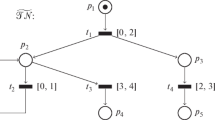Abstract
We present a methodology of off-line analysis of real-time systems, composed of periodic, synchronous or asynchronous precedence and resource constrained real-time tasks. As there is no polynomial optimal scheduling technique for such tasks sets, we present an enumerative method based on the construction of the state graph of a Petri net. The time is modeled by the Petri net through the earliest firing rule.
Similar content being viewed by others
References
Baker, K., and Su, Z. 1974. Sequencing with due-dates and early start times to minimize maximum tardiness. Naval Research Logistic Quarterly 21: 171-176.
Baker, T. 1991. Stack-based scheduling of real-time processes. The Journal of Real-Time Systems 3: 67-99.
Baruah, S., Rosier, L., and Howell, R. 1990. Algorithms and complexity concerning the preemptive scheduling of periodic, real-time tasks on one processor. Real-Time Systems 2: 301-324.
Berthomieu, B., and Diaz, M. 1991. Modeling and verification of time dependent systems using time Petri nets. IEEE Transactions on Software Engineering 17(3): 259-273.
Bratley, P., Florian, M., and Robillard, P. 1975. Scheduling with earliest start and due date constraints on multiple machines. Naval Research Logistic Quarterly 22(1): 165-173.
Buttazzo, G. 1997. Hard real-time computing systems. Kluwer Academic Publishers.
Chen, M., and Lin, K. 1990. Dynamic priority ceilings: A concurrency control protocol for real-time systems. Real-Time Systems 2(4): 325-346.
Grolleau, E. 1999. Ordonnancement temps réel hors-ligne optimal à laide de réseaux de Petri en environnement monoprocesseur et multiprocesseur. Ph.D. thesis, ENSMA-Universite de Poitiers.
Joseph, M. C. 1996. Real-time systems, specification, verification and analysis. Prentice Hall.
Kaiser, C. 1982. Exclusion mutuelle et ordonnancement par priorité. Technique et Science Informatiques 1(1): 59-68.
Leung, J., and Merrill, M. 1980. A note on preemptive scheduling of periodic real-time tasks. Information Processing Letters 11(3): 115-118.
Liu, C., and Layland, J. 1973. Scheduling algorithms for multiprogramming in real-time environment. Journal of the ACM 20(1): 46-61.
Menasche, M., and Berthomieu, B. 1983. Time Petri nets for analyzing and verifying time dependent communication protocols. In H. R. West and C.H. (eds): Protocol Specification, Testing, and Verification, IFIP, 3: 161-172.
Merlin, P., and Farber, D. 1976. Recoverability of communication protocols—Implications of a theoretical study. IEEE Transactions on Communications 1036-1043.
Mok, A. 1983. Fundamental design problems of distributed systems for the hard real-time environment. Ph.D. thesis, Massachussets Institute of Technologie.
Mok, A., and Dertouzos, M. 1978. Multiprocessor scheduling in a hard real-time environment. In: 7th Texas Conference on Computer Systems 5.1-5.12.
Monnier, Y., Beauvais, J., and Deplanche, A.-M. 1998. A genetic algorithm for scheduling tasks in a real-time distributed system. In: 24th Euromicro Conference. Vasteras, Sweden.
Murata, T. 1989. Petri nets: Properties, analysis and applications. Proc. of the IEEE 17(3): 541-580.
Peterson, J. 1981. Petri nets theory and the modeling of systems. Prentice-Hall.
Petri, C. 1962. Kommunikation mit automaten. Ph.D. thesis, Bonn Institut fur Instrumentelle Mathematik.
Ramchandani, C. 1974. Analysis of asynchronous concurrent systems by timed Petri nets. Ph.D., MIT.
Sha, L., Rajkumar, R., and Lehoczky, J. 1990. Priority inheritance protocols: An approach to real-time synchronization. IEEE Transactions on Computers 39(9): 1175-1185.
Stankovic, J. 1988. Misconceptions about real-time computing. Computer 21(10): 10-19.
Stankovic, J., Spuri, M. Ramamritham, K., and Buttazzo, G. 1998. Deadline scheduling for real-time systems. Kluwer Academic Publishers.
Starke, P. 1990. Some properties of timed nets under the earliest firing rule. Advances in Petri nets 1989, Venice in Lecture Notes in Computer Science 424: 418-432.
Tsai, J., Yang, S., and Chang, Y.-H. 1995. Timing constraint Petri nets and their application to schedulability analysis of real-time system specifications. IEEE Transactions on Software Engineering 21(1): 32-49.
Valk, R., and Vidal-Naquet, G. 1981. Petri nets and regular languages. Journal of Computer and System Sciences 23(3): 399-325.
Xu, J., and Parnas, D. 1990. Scheduling processes with release times, deadlines, precedence, and exclusion relations. IEEE Transactions on Software Engineering 16(3): 360-369.
Zamorano, J., Alonso, A., and Puente, J. D. L. 1997. Automatic generation of cyclic schedules. In WRTP'97, 22nd IFACIFIP Workshop on Real-Time Programming. Elsevier Science, 145-151.
Author information
Authors and Affiliations
Rights and permissions
About this article
Cite this article
Grolleau, E., Choquet-Geniet, A. Off-Line Computation of Real-Time Schedules Using Petri Nets. Discrete Event Dynamic Systems 12, 311–333 (2002). https://doi.org/10.1023/A:1015673516542
Issue Date:
DOI: https://doi.org/10.1023/A:1015673516542




